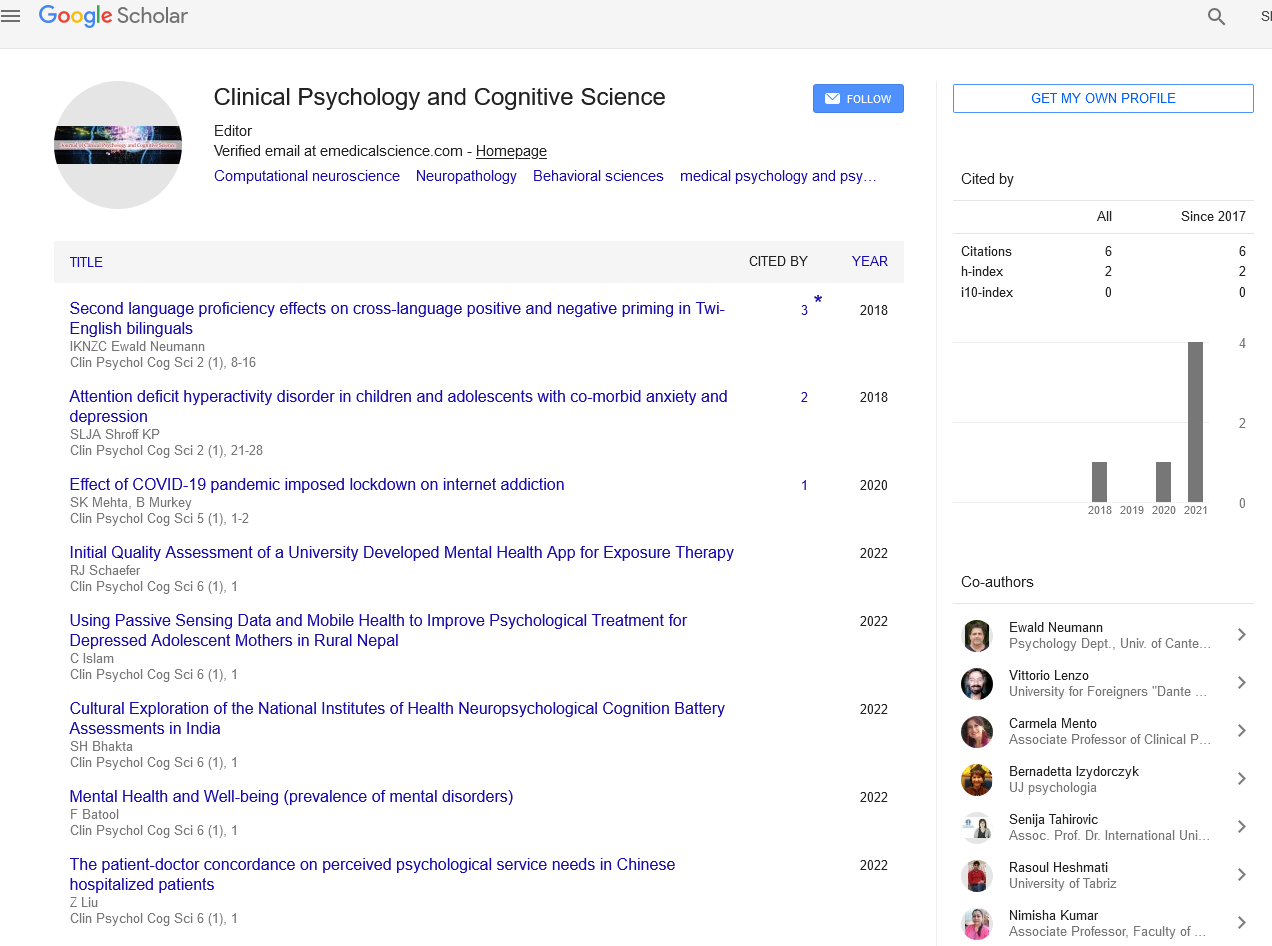Relating aspects of panic disorder and agoraphobia
Received: 08-Nov-2021 Accepted Date: Nov 22, 2021; Published: 29-Nov-2021
Citation: Barr T. Relating aspects of panic disorder and agoraphobia. Clin Psychol Cog Sci. 2021;5(3):10.
This open-access article is distributed under the terms of the Creative Commons Attribution Non-Commercial License (CC BY-NC) (http://creativecommons.org/licenses/by-nc/4.0/), which permits reuse, distribution and reproduction of the article, provided that the original work is properly cited and the reuse is restricted to noncommercial purposes. For commercial reuse, contact reprints@pulsus.com
Abstract
In recent years, panic disorder (PD) has been recognized as a chronic illness with little spontaneous improvement in patients and a non-uniform course of illness. Agoraphobia (AG) is an anxiety symptom, to be in a place or situation where it is difficult (or embarrassing) to escape, or where there is no help in the event of an unexpected or situational panic attack (PA) or panic symptoms. Agoraphobia fear usually involves a set of unique situations, including being alone outside the house, being in the crowd or lined up; being on a bridge, travel by bus, train or car. There seems to be a clear link between panic attacks and the onset of agoraphobia. This concept is supported by current biological and psychological models of PD and AG. Early predictors of the onset of AG are important in clinical practice because coexisting AG leads to poor outcome and/or severe PD. The earliest possible predictor of the onset of AG in PD patients is characteristic of the First Panic Attack (FPA). One of the key characteristics of a patient's FPA is the location or situation in which the person experienced the FPA.
Description
In recent years, panic disorder (PD) has been recognized as a chronic illness with little spontaneous improvement in patients and a non-uniform course of illness. Agoraphobia (AG) is an anxiety symptom, to be in a place or situation where it is difficult (or embarrassing) to escape, or where there is no help in the event of an unexpected or situational panic attack (PA) or panic symptoms. Agoraphobia fear usually involves a set of unique situations, including being alone outside the house, being in the crowd or lined up; being on a bridge, travel by bus, train or car.
There seems to be a clear link between panic attacks and the onset of agoraphobia. This concept is supported by current biological and psychological models of PD and AG. Early predictors of the onset of AG are important in clinical practice because coexisting AG leads to poor outcome and/or severe PD. The earliest possible predictor of the onset of AG in PD patients is characteristic of the First Panic Attack (FPA). One of the key characteristics of a patient's FPA is the location or situation in which the person experienced the FPA.
The relationship between the situation in which the FPA took place and the subsequent development of AG is still controversial. Several previous studies have shown that people who have experienced FPA in public places or in disgusting situations are more likely to diagnose PD as AG. Schulman et al. Frequent avoiders reported that they were more likely to experience FPA in classic agoraphobic situations such as driving a car or public transport. In addition, Amering et al. reported that the public appearance of the FPA and the associated embarrassment had a major bearing on the development of AG.
On the other hand, comparisons between groups of patients with minimal, moderate, and high avoidance showed no difference in the location of FPA or in the patient's beliefs about what happened to the patient. Craske et al. reported that the various locations where FPA occurred are evenly divided into minimal avoidance and widespread avoidance. In addition, some patients who experienced FPA at home also developed AG. Previous studies found that the proportion of AG patients who reported FPA at home was 8%, 10.3%, and 17%, respectively. In a study comparing minimal and widespread avoiders, the proportion of widespread avoiders who experienced FPA at home was 2.6% and 29.4%, respectively.
These reviews recommend an affiliation among the place of the FPA and next avoidance behaviours. However, the outcomes stay inconclusive and investigations into different scientific factors, which include demography and signs and symptoms skilled all through the FPA, have now no longer been conducted.
The relation between agoraphobia and panic disorder stays now no longer been genuinely established. Regarding this issue, 2 hypotheses had been proposed. It has been advised that agoraphobia is a subtype of panic disorder. Grant et al. stated that panic disorder observed through agoraphobia might be an intense difficulty of panic disorder, and agoraphobia became taken into consideration to end result from recurrent panic attacks. On the other side, agoraphobia might be a unique sickness impartial of panic disorder. Recently, with inside the DSM-5, agoraphobia has been separated from panic disorder as an impartial condition, primarily based totally on the subsequent findings. Agoraphobia should arise without panic signs and symptoms, isn't always continually secondary to panic signs and symptoms, and there are variations in prevalence, intercourse unique occurrence rate, and remedy final results among agoraphobia and panic disorder.
There is evidence that the presence of agoraphobia in patients with panic disorder has significant clinical implications, but in terms of symptom severity and psychological comorbidities, coexisting agoraphobia symptoms are associated with panic disorder. Few comprehensive reviews have been reported on how it affects patients which compares the severity of panic disorder symptoms, coexisting psychological symptoms, and clinical course including medication between patients with panic disorder with agoraphobia (PDA) and patients with panic disorder only (PD).





